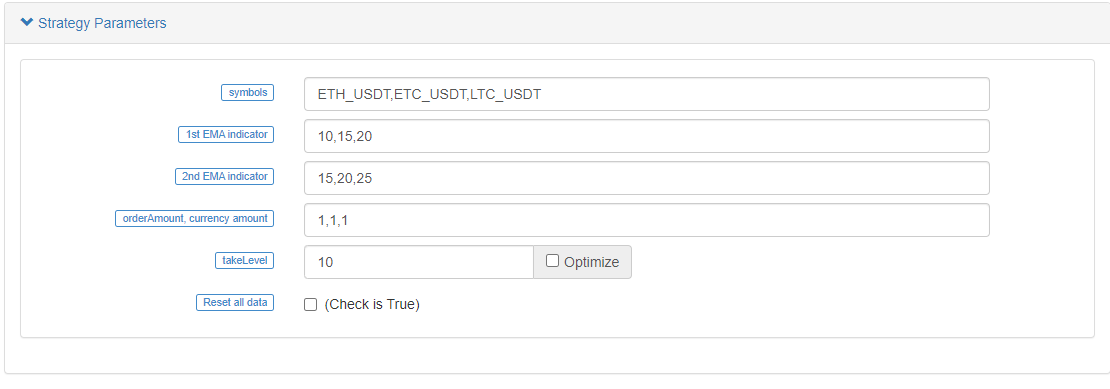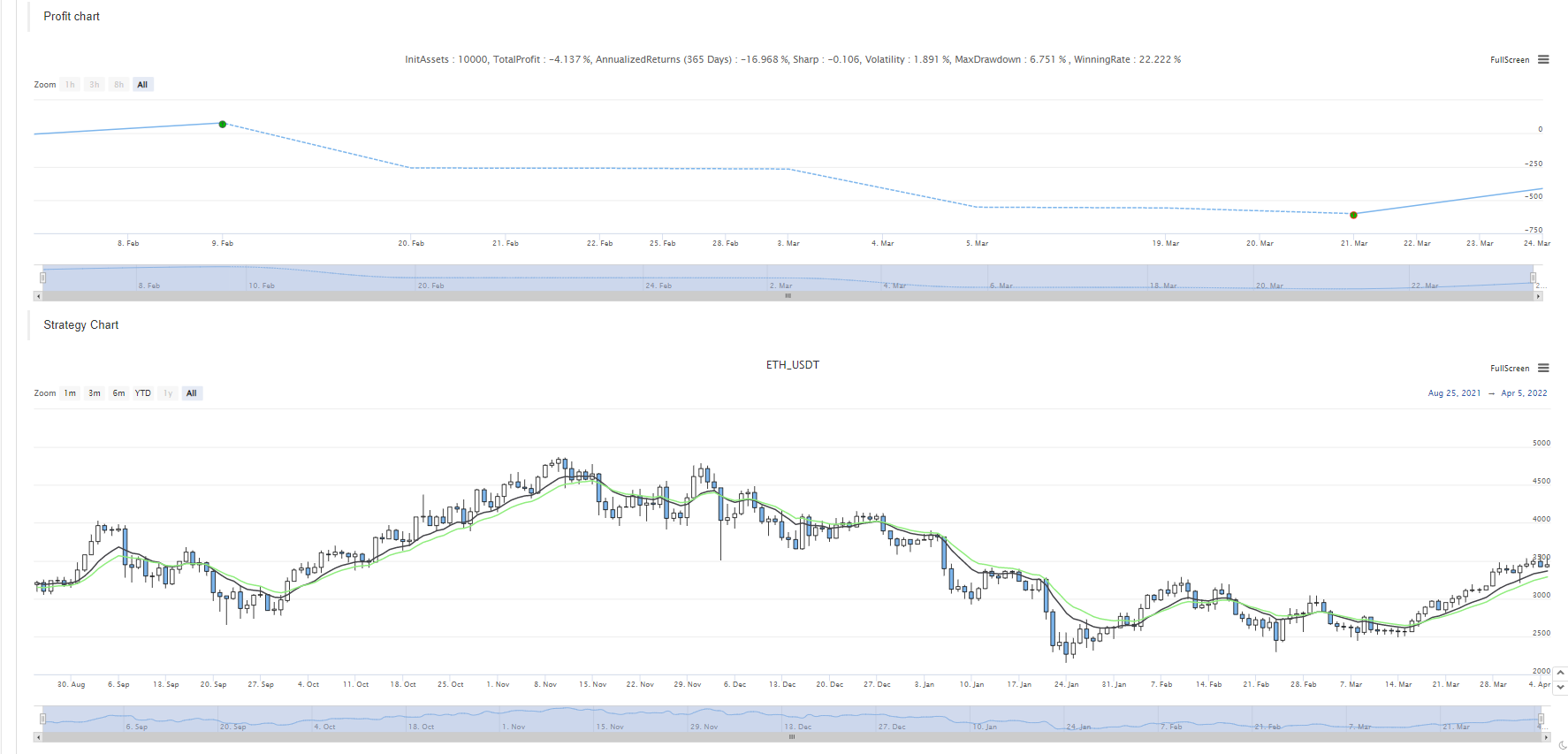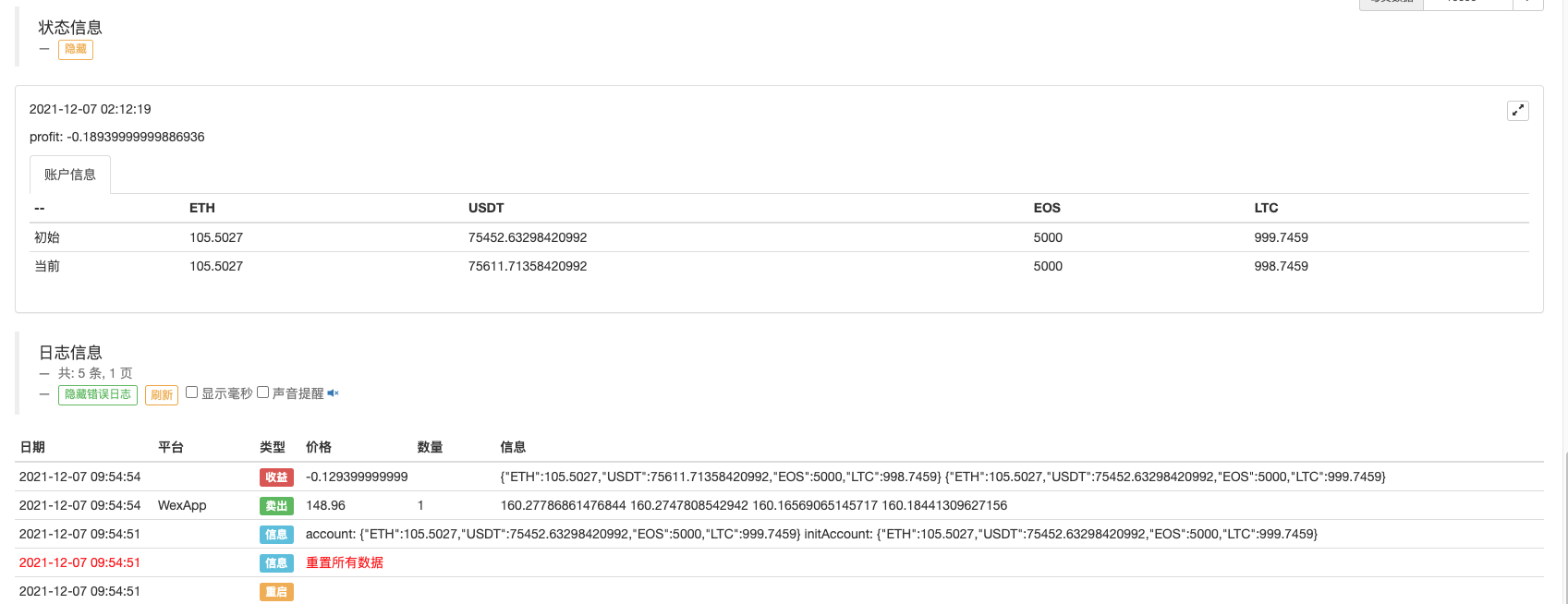Stratégie des moyennes mobiles doubles multi-symbole de crypto-monnaie (enseignement)
Auteur:Je suis désolée., Créé à: 2022-04-07 16:14:35, Mis à jour à: 2022-04-08 09:13:58Stratégie des moyennes mobiles doubles multi-symbole de crypto-monnaie (enseignement)
À la demande de nos utilisateurs sur les forums qui espèrent avoir une stratégie de moyenne mobile double multi-symbole comme référence de conception, une stratégie de moyenne mobile double multi-symbole sera mise en œuvre dans le partage d'aujourd'hui.
Réflexion stratégique
La logique de la stratégie de la moyenne mobile double est très simple, c'est-à-dire deux moyennes mobiles. Une moyenne mobile avec une petite période (ligne rapide) et une moyenne mobile avec une grande période (ligne lente). Lorsque les deux lignes ont une croix dorée (la ligne rapide croise la ligne lente depuis le bas), acheter long, et lorsque les deux lignes ont une croix morte (la ligne rapide vers le bas croise la ligne lente depuis le haut), vendre court. Pour la moyenne mobile, nous utilisons l'EMA.
C'est juste que la stratégie doit être conçue pour plusieurs symboles, de sorte que les paramètres de différents symboles peuvent être différents (différents symboles utilisent différents paramètres de moyenne mobile), il est donc nécessaire de concevoir des paramètres dans un tableau de paramètres.

Les paramètres sont conçus sous la forme d'une chaîne, avec chaque paramètre divisé par une virgule. Ces chaînes sont analysées lorsque la stratégie commence à fonctionner, ce qui sera associé à la logique d'exécution pour chaque symbole (paire de trading).
La stratégie est conçue de manière très simple et très adaptée aux débutants; elle ne comporte que plus de 200 lignes au total.
Code de stratégie
// function effect: to cancel all pending orders of the current trading pair
function cancelAll(e) {
while (true) {
var orders = _C(e.GetOrders)
if (orders.length == 0) {
break
} else {
for (var i = 0 ; i < orders.length ; i++) {
e.CancelOrder(orders[i].Id, orders[i])
Sleep(500)
}
}
Sleep(500)
}
}
// function effect: to calculate the real-time profit and loss
function getProfit(account, initAccount, lastPrices) {
// account indicates the current account information; initAccount is the initial account information; lastPrices is the the latest prices of all current symbols
var sum = 0
_.each(account, function(val, key) {
// traverse the current total assets, and calculate asset currency (except USDT) difference and amount difference
if (key != "USDT" && typeof(initAccount[key]) == "number" && lastPrices[key + "_USDT"]) {
sum += (account[key] - initAccount[key]) * lastPrices[key + "_USDT"]
}
})
// return the asset profit and loss calculated by the current price
return account["USDT"] - initAccount["USDT"] + sum
}
// function effect: to generate chart configuration
function createChartConfig(symbol, ema1Period, ema2Period) {
// symbol indicates trading pair; ema1Period indicates the first EMA period; ema2Period indicates the second EMA period
var chart = {
__isStock: true,
extension: {
layout: 'single',
height: 600,
},
title : { text : symbol},
xAxis: { type: 'datetime'},
series : [
{
type: 'candlestick', // K-line date series
name: symbol,
id: symbol,
data: []
}, {
type: 'line', // EMA data series
name: symbol + ',EMA1:' + ema1Period,
data: [],
}, {
type: 'line', // EMA data series
name: symbol + ',EMA2:' + ema2Period,
data: []
}
]
}
return chart
}
function main() {
// reset all data
if (isReset) {
_G(null) // vacuum all persistently recorded data
LogReset(1) // vacuum all logs
LogProfitReset() // vacuum all profit logs
LogVacuum() // release the resource occupied by the bot database
Log("reset all data", "#FF0000") // print information
}
// parse parameters
var arrSymbols = symbols.split(",") // use comma to split the trading symbol strings
var arrEma1Periods = ema1Periods.split(",") // split the string of the first EMA parameter
var arrEma2Periods = ema2Periods.split(",") // split the string of the second EMA parameter
var arrAmounts = orderAmounts.split(",") // split the order amount of each symbol
var account = {} // the variable used to record the current asset information
var initAccount = {} // the variable used to record the initial asset information
var currTradeMsg = {} // the variable used to record whether the current BAR is executed
var lastPrices = {} // the variable used to record the latest price of the monitored symbol
var lastBarTime = {} // the variable used to record the time of the latest BAR, to judge the BAR update during plotting
var arrChartConfig = [] // the variable used to record the chart configuration information, to plot
if (_G("currTradeMsg")) { // for example, when restart, recover currTradeMsg data
currTradeMsg = _G("currTradeMsg")
Log("recover GetRecords", currTradeMsg)
}
// initialize account
_.each(arrSymbols, function(symbol, index) {
exchange.SetCurrency(symbol)
var arrCurrencyName = symbol.split("_")
var baseCurrency = arrCurrencyName[0]
var quoteCurrency = arrCurrencyName[1]
if (quoteCurrency != "USDT") {
throw "only support quoteCurrency: USDT"
}
if (!account[baseCurrency] || !account[quoteCurrency]) {
cancelAll(exchange)
var acc = _C(exchange.GetAccount)
account[baseCurrency] = acc.Stocks
account[quoteCurrency] = acc.Balance
}
// initialize the related data of chart
lastBarTime[symbol] = 0
arrChartConfig.push(createChartConfig(symbol, arrEma1Periods[index], arrEma2Periods[index]))
})
if (_G("initAccount")) {
initAccount = _G("initAccount")
Log("recover initial account information", initAccount)
} else {
// use the current asset information to initialize initAccount (variable)
_.each(account, function(val, key) {
initAccount[key] = val
})
}
Log("account:", account, "initAccount:", initAccount) // print asset information
// initialize the chart objects
var chart = Chart(arrChartConfig)
// reset chart
chart.reset()
// strategy logic of the main loop
while (true) {
// traverse all symbols, and execute the dual moving average logic one by one
_.each(arrSymbols, function(symbol, index) {
exchange.SetCurrency(symbol) // switch the trading pair to the trading pair recorded by by symbol string
var arrCurrencyName = symbol.split("_") // split trading pairs by "_"
var baseCurrency = arrCurrencyName[0] // string of base currency
var quoteCurrency = arrCurrencyName[1] // string of quote currency
// according to index, obtain the EMA paramater of the current trading pair
var ema1Period = parseFloat(arrEma1Periods[index])
var ema2Period = parseFloat(arrEma2Periods[index])
var amount = parseFloat(arrAmounts[index])
// obtain the K-line data of the current trading pair
var r = exchange.GetRecords()
if (!r || r.length < Math.max(ema1Period, ema2Period)) { // when the length of K-line is not long enough, return directly
Sleep(1000)
return
}
var currBarTime = r[r.length - 1].Time // record the current BAR timestamp
lastPrices[symbol] = r[r.length - 1].Close // record the current latest price
var ema1 = TA.EMA(r, ema1Period) // calculate EMA indicator
var ema2 = TA.EMA(r, ema2Period) // calculate EMA indicator
if (ema1.length < 3 || ema2.length < 3) { // when the length of EMA indicator array is too short, return derectly
Sleep(1000)
return
}
var ema1Last2 = ema1[ema1.length - 2] // EMA on the second last BAR
var ema1Last3 = ema1[ema1.length - 3] // EMA on the third last BAR
var ema2Last2 = ema2[ema2.length - 2]
var ema2Last3 = ema2[ema2.length - 3]
// write the chart data
var klineIndex = index + 2 * index
// traverse k-line data
for (var i = 0 ; i < r.length ; i++) {
if (r[i].Time == lastBarTime[symbol]) { // plot; update the current BAR and its indicator
// update
chart.add(klineIndex, [r[i].Time, r[i].Open, r[i].High, r[i].Low, r[i].Close], -1)
chart.add(klineIndex + 1, [r[i].Time, ema1[i]], -1)
chart.add(klineIndex + 2, [r[i].Time, ema2[i]], -1)
} else if (r[i].Time > lastBarTime[symbol]) { // plot; add BAR and its indicator
// add
lastBarTime[symbol] = r[i].Time // update the timestamp
chart.add(klineIndex, [r[i].Time, r[i].Open, r[i].High, r[i].Low, r[i].Close])
chart.add(klineIndex + 1, [r[i].Time, ema1[i]])
chart.add(klineIndex + 2, [r[i].Time, ema2[i]])
}
}
if (ema1Last3 < ema2Last3 && ema1Last2 > ema2Last2 && currTradeMsg[symbol] != currBarTime) {
// golden cross
var depth = exchange.GetDepth() // obtain the depth data of the current order book
var price = depth.Asks[Math.min(takeLevel, depth.Asks.length)].Price // select the 10th level price; taker
if (depth && price * amount <= account[quoteCurrency]) { // obtain that the depth data is normal, and the assets are enough to place an order
exchange.Buy(price, amount, ema1Last3, ema2Last3, ema1Last2, ema2Last2) // maker; buy
cancelAll(exchange) // cancel all pending orders
var acc = _C(exchange.GetAccount) // obtain the account asset information
if (acc.Stocks != account[baseCurrency]) { // detect the account assets changed
account[baseCurrency] = acc.Stocks // update assets
account[quoteCurrency] = acc.Balance // update assets
currTradeMsg[symbol] = currBarTime // record the current BAR has been executed
_G("currTradeMsg", currTradeMsg) // persistently record
var profit = getProfit(account, initAccount, lastPrices) // calculate profit
if (profit) {
LogProfit(profit, account, initAccount) // print profit
}
}
}
} else if (ema1Last3 > ema2Last3 && ema1Last2 < ema2Last2 && currTradeMsg[symbol] != currBarTime) {
// death cross
var depth = exchange.GetDepth()
var price = depth.Bids[Math.min(takeLevel, depth.Bids.length)].Price
if (depth && amount <= account[baseCurrency]) {
exchange.Sell(price, amount, ema1Last3, ema2Last3, ema1Last2, ema2Last2)
cancelAll(exchange)
var acc = _C(exchange.GetAccount)
if (acc.Stocks != account[baseCurrency]) {
account[baseCurrency] = acc.Stocks
account[quoteCurrency] = acc.Balance
currTradeMsg[symbol] = currBarTime
_G("currTradeMsg", currTradeMsg)
var profit = getProfit(account, initAccount, lastPrices)
if (profit) {
LogProfit(profit, account, initAccount)
}
}
}
}
Sleep(1000)
})
// variables in the table of status bar
var tbl = {
type : "table",
title : "account information",
cols : [],
rows : []
}
// write the data in the table structure of status bar
tbl.cols.push("--")
tbl.rows.push(["initial"])
tbl.rows.push(["current"])
_.each(account, function(val, key) {
if (typeof(initAccount[key]) == "number") {
tbl.cols.push(key)
tbl.rows[0].push(initAccount[key]) // initial
tbl.rows[1].push(val) // current
}
})
// display the status bar table
LogStatus(_D(), "\n", "profit:", getProfit(account, initAccount, lastPrices), "\n", "`" + JSON.stringify(tbl) + "`")
}
}
Retour sur la stratégie



Vous pouvez voir ETH, LTC et ETC ont tous eu des transactions selon les déclencheurs de la croix d'or et la croix de la mort des moyennes mobiles.

Vous pouvez aussi attendre le robot simulé pour le tester.
Le code source de la stratégie:https://www.fmz.com/strategy/333783
La stratégie n'est utilisée que pour les backtests et l'apprentissage de la conception de stratégies, alors utilisez-la avec prudence dans un bot.
- Une plateforme de paiement basée sur FMZ
- Contrats de crypto-monnaie Robot simple de supervision des ordres
- Vous voulez obtenir le temps correspondant lorsque vous utilisez getdepth
- Ignoré, résolu
- Le problème de la valeur
- Exemple de conception de stratégie dYdX
- Exploration initiale de l'application de Python Crawler sur FMZ
Crawling Contenu de l'annonce de Binance - Définition de la stratégie de couverture Recherche et exemple d'ordres en attente au comptant et à terme
- Situation récente et fonctionnement recommandé de la stratégie de taux de financement
- Stratégie de point de rupture à moyenne mobile double des contrats à terme sur crypto-monnaie (enseignement)
- Réalisation de l'indicateur Fisher en JavaScript et de la planification sur FMZ
- Le gérant
- 2021 Cryptocurrency TAQ Review & Stratégie manquée la plus simple d'augmentation de 10 fois
- Stratégie ART multi-symbole sur les contrats à terme de crypto-monnaie (enseignement)
- Mise à niveau! Stratégie de Martingale sur les contrats à terme de crypto-monnaie
- La fonction Getrecords n'arrive pas à récupérer le schéma de K en secondes
- Conception d'un système de gestion synchrone basé sur les ordres FMZ (2)
- Les données de volume retournées par Getticker sont incorrectes.
- Conception d'un système de gestion synchrone basé sur les ordres FMZ (1)
- Concevoir une bibliothèque de tracés à plusieurs graphiques